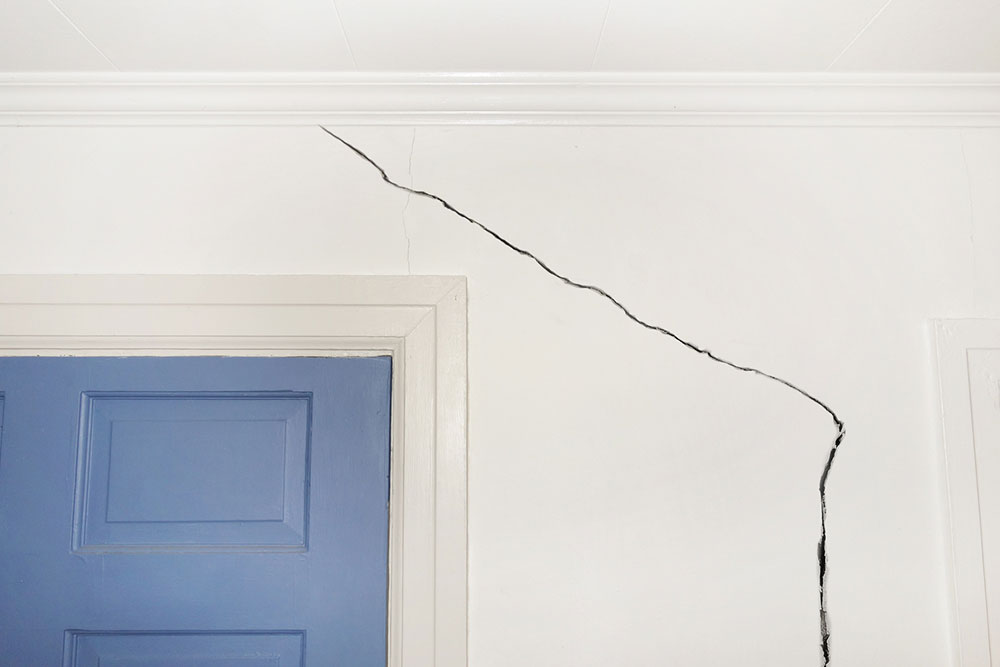10 signs of home foundation problems

The foundation of a home gives it structure, stability, and support that ensures it remains sturdy for a long time. However, a building is often exposed to things like extreme weather conditions, vibrations from other construction sites, poor drainage, and erosion that might damage the foundation. When left unchecked, foundation damage can become difficult and expensive to fix. That’s why it is important to address signs of foundation damage immediately.
1. Warped or cracked siding
Siding is wall cladding or protective material attached to the exterior side of walls. It can warp or develop cracks due to pest damage, extreme weather, or moisture. While these are contributing factors, siding that warps or cracks is also a sign of issues with the foundation. One should look for gaps between plants, space between the siding and window or door frames, and growing cracks along the exterior walls. The cracks and gaps might also make room for more moisture or pests, which might damage the foundation further.
2. Drainage problems
f the foundation becomes unlevelled, one might notice problems with the plumbing. For instance, a foundation that shifts, cracks, or sinks might cause pipes running through the house to back up or become unbalanced and restrict water flow. Drainage issues usually develop alongside other signs, like issues with the siding, walls, and floors. If one notices drainage problems accompanied by these issues, one should check the foundation for damages and get them fixed at the earliest.
3. Cracks in the walls
Cracks in the walls, often a telltale sign of foundation damage, may develop inside or outside the home. The cracks might start small and widen over time. A horizontal crack is usually more concerning, as it indicates a shifting or settling foundation. Vertical cracks can be a result of normal settlement, but if they are wider at the top than the bottom, they could be a sign of foundation settlement issues.
4. Mildew
One might be able to smell mold or mildew in a home for various reasons, including poor ventilation and leaky pipes. But, a persistent odor might have something to do with a poor or failing foundation. The smell of mildew or mold might be a result of moisture seeping via small cracks in the foundation. This moisture may lead to more rot and attract pests, which is equally hazardous for the foundation.
5. Cracked or leaning chimney
An unbalanced or unleveled foundation can make the chimney break or crack. Sometimes, the entire section might become crooked and lean. While cracks are easier to detect, one could tell if the chimney is leaning by looking at its placement along the side of the home. If there is a space between the exterior of the house and the chimney, it is leaning, and one might need to fix the foundation.
6. Bouncy floors
A bouncy floor could be mistaken for loose floorboards. But there might be more to it. If a floorboard squeaks, sags, or bounces, it could be a sign the foundation has settled or that the structural beams are rotting away. It would be a good idea to get the floors as well as the foundation checked to determine the source of the problem. Those in homes with concrete slab floors, such as in a basement or crawl space, should look for cracks to see if there are issues with the foundation.
7. Doors that stick
A problematic foundation might cause the house to sink or become uneven in various places. If this happens, one might notice that doors do not shut properly or get stuck. One should note that a door might scrape the ground while being closed or opened for other reasons, such as swelling when the humidity is higher. However, if the door is warped much more than expected, one should hire a professional to inspect the foundation.
8. Drywall nail pops
Nails can pop out from drywall once in a while and can be hammered back in. However, if all the nails on the wall start to pop out, one might need to take the issue seriously. If the foundation sinks, the drywall in the home might shift with it. As a result, the nails move and come out of the wall. This sign of foundation damage can be observed both inside and outside the home.
9. Cabinets separated from walls
A problem with the home’s foundation might cause the floors and walls to become uneven. While this might not be too easy to notice, one could assess the issue by paying close attention to countertops and cabinets. If the furnishings were previously attached firmly to the walls or level with the ground and are now separated from the wall or sloping, one might be dealing with foundation damage.
10. Sinking ground
A home is typically graded so that melted snow and rain flow away from the foundation, as moisture may affect the integrity of the foundation. However, if the water gradually starts to pool around the base of a home, it could be the onset of a severe structural problem. Here, the foundation may have started to sink, creating shallow pockets in the ground. As a result, moisture may collect in one place, seep through the ground, and further damage the foundation.